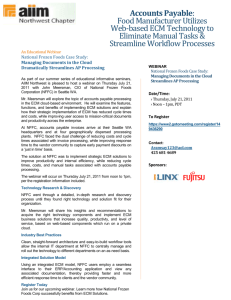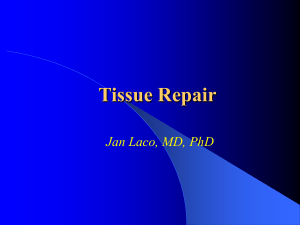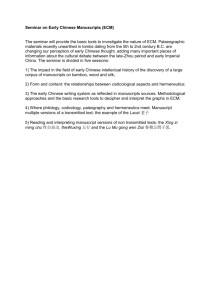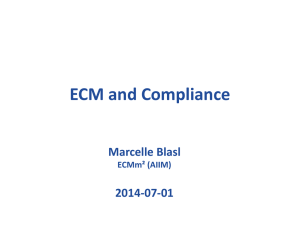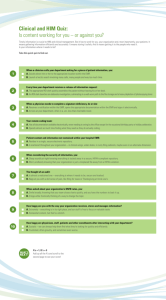The Extracellular Matrix in Tissue Regeneration
advertisement
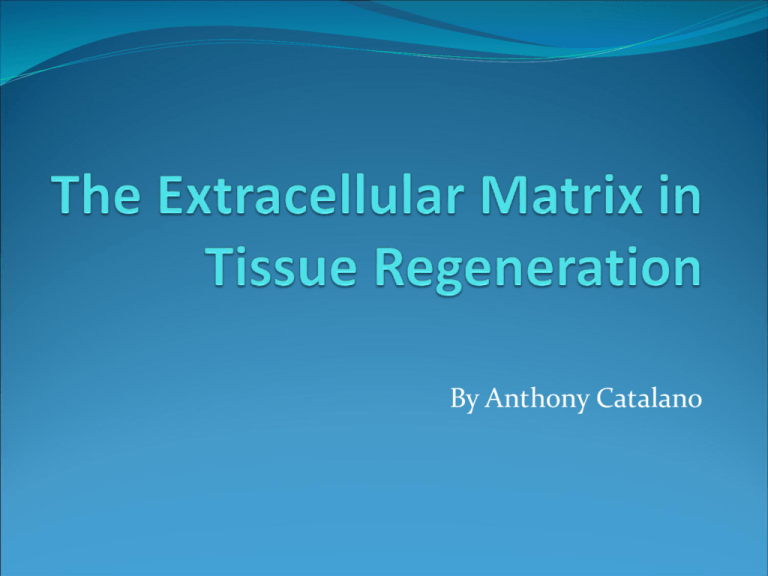
By Anthony Catalano The Extracellular Matrix (ECM) Provides support to tissue Composed of fibers: Collagen and Elastin Made up of cells called Fibroblasts Found in intercellular cavities Discovery of ECM as a “Bioscaffold” 1989- Dr. Stephen Dr. Stephen Badylak Badylak performed Aortic surgery (Cardiomyoplasty) on a canine Replaced canine’s Aorta with a segment of the canine’s small intestine Canine survived surgery and lived for another 8 years Further investigation of the ECM Dr. Stephen Badylak determined it was the ECM that was the root cause of the successful surgery Experimented on Xenogeneic ECM extracted from a pig bladder Removed all cells from ECM Performed same surgery with decellularized ECM Physiology of Dr. Badylak’s Discovery The ECM contains cells called fibroblasts When tissue becomes damaged, fibroblasts secrete excess collagen to damaged site The ECM scaffold prevents inflammation and excess collagen by promoting the secretion of growth factors The growth factors prevent the immune system from secreting excess collagen and instead stimulates the body to repair tissue Types of ECM scaffolding Today 1.)Hydrated sheet ECM 2.)Lyophilized powdered ECM (15mg-$400.00-CellAdhere™ ) 3.)ECM Gel (10ml-$175.88- Gibco®) Advantages and Disadvantages of ECM scaffolding PROS Biocompatibility No immune (postsurgery) drugs required Regain of tissue function Regeneration of tissue without use of controversial harvesting of stem cells CONS Dependant on percentage of lost or damaged tissue (%2580% max) External Scarring Recovery Rate (1-2 months) Current Use of ECM scaffolds FDA approved for clinical use in 1999 Dr. Stephen Badylak is working with wounded veterans to replace lost muscle tissue 80 patient study, 5 patients treated, all successful in regaining muscle function Average of 12-15% regain in muscle mass Marine Sgt. Ron Strang Corporal Isaias Hernandez Future of ECM Scaffolding Use for hospitals and the military Portable regenerative medicine for use at home (Band-Aids) Rebuilding limbs or other artificial body parts* Quicker recovery rate Lower Cost References Badylak, Stephen, Dr. "The Extracellular Matrix as a Scaffold for Tissue Reconstruction." CELL & DEVELOPMENTAL BIOLOGY (2002): Pgs:377-382 Web. Piore, Adam. "Discover Magazine." The Healing Power from Within 7 July 2011: 68-88. Web. Valentin, J. E., J. S. Badylak, G. P. McCabe, and S. F. Badylak. "Extracellular Matrix Bioscaffolds for Orthopaedic Applications. A Comparative Histologic Study." The Journal of Bone and Joint Surgery 88.12 (2006): 2673-686. Print. "Extracellular Matrix." Wikipedia. Wikimedia Foundation, 16 Oct. 2012. Web. 17 Oct. 2012. <http://en.wikipedia.org/wiki/Extracellular_matrix>. Badylak, S. "Xenogeneic Extracellular Matrix as a Scaffold for Tissue Reconstruction.“ Transplant Immunology 12.3-4 (2004): 367-77. Print. Sell, Scott A., Patricia S. Wolfe, Koyal Garg, Jennifer M. McCool, Isaac A. Rodriguez, and Gary L. Bowlin. "The Use of Natural Polymers in Tissue Engineering: A Focus on Electrospun Extracellular Matrix Analogues." Polymers 2.4 (2010): 522-53. Print.



